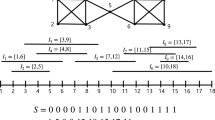Abstract
We study the complexity of graph problems succinctly encoded by bounded depth circuits and the existence of upward translation theorems for these models. While almost all succinct encodings have an upward translation theorem for some type of reduction, we prove that such theorems for CNF- and DNF-encoded graphs and for the most studied reductions do not exist. In contrast, we show that there are upward translation theorems for AC0 circuits of depth at least 3. This implies that the complexity of the succinct versions of problems complete for NP (under quantifier-free reductions), encoded by such circuits, have an exponential blow-up. We adapt these results to problems on explicitly given graphs with the same structural properties as graphs encoded by bounded depth circuits. We define a graph class hierarchy \(\mathcal {I}^{k}\) which consists of at most k alternating unions and intersections of edge-sets in \(\mathcal {I}^{0}\), a class which only consists of single bicliques. We show that the complexity of every NP-complete problem (under quantifier-free reductions) collapses to the second level: on graphs in \(\mathcal {I}^{2}\) the problem is already NP-complete. Finally, we show that by restricting \(\mathcal {I}^{2}\) to use only sub-logarithmic many intersections we get graphs for which Dominating Set is not NP-complete unless the Exponential Time Hypothesis is false. In contrast, a degree of O(log n) is enough for NP-completeness. Therefore, Dominating Set on \(\mathcal {I}^{2}\) graphs with intersection-degree O(logδ(n)) has either a spontaneous transition from P (for all δ < 1) to NP-complete (for δ = 1), or is NP-intermediate on the restricted graph class (for some δ < 1).
Similar content being viewed by others
Explore related subjects
Discover the latest articles and news from researchers in related subjects, suggested using machine learning.Notes
If a class C may only use time or space bounded by a set of functions {f i (n)} i=1,2,…, then e x p C should denote the class with the same resource bounded by \(\{2^{f_{i}(n)}\}_{i = 1, 2, \ldots }\). For example, if C = NP, then e x p C = NEXP.
As we will use both concepts simultaneously, we need two different notions and therefore deviate from the usual notation.
In this notation, constant does not mean the value is fixed for all inputs but rather that it is a single element in the universe as opposed to relations over the universe.
This is just a brute-force transformation of O R ∘ A N D into A N D ∘ O R which canonly be done in polynomial-time as the fan-in of the disjunction gate is bounded by the constant o ∈ ℕ and the fan-in of the conjunction is bounded by a polynomial.
For every n, there are only p o l y(n) many non-isomorphic bicliques (or their complements) of size at most n.
References
Alon, N.: Covering graphs by the minimum number of equivalence relations. Combinatorica 6(3), 201–206 (1986). doi:10.1007/BF02579381
Babai, L., Frankl, P., Simon, J.: Complexity classes in communication complexity theory Proceedings of the 27th Annual Symposium on Foundations of Computer Science, SFCS’86, pp 337–347. IEEE Computer Society, Washington (1986), doi:10.1109/SFCS.1986.15
Balcázar, J.L., Lozano, A., Torán, J.: The complexity of algorithmic problems on succinct instances. Computer Science, Research and Applications, pp 351–377. Springer, US (1992)
Chlebík, M., Chlebíková, J.: Approximation hardness of dominating set problems in bounded degree graphs. Inf. Comput. 206(11), 1264–1275 (2008). doi:10.1016/j.ic.2008.07.003
Cook, S.A.: A hierarchy for nondeterministic time complexity. J. Comput. Syst. Sci. 7(4), 343–353 (1973). doi:10.1016/S0022-0000(73)80028-5
Dahlhaus, E.: Reduction to NP-complete problems by interpretations Logic and Machines: Decision Problems and Complexity, Proceedings of the Symposium “Rekursive Kombinatorik” held from May 23-28, 1983 at the Institut für Mathematische Logik und Grundlagenforschung der Universität Münster/Westfalen, pp. 357–365 (1983), doi:10.1007/3-540-13331-3_51
Das, B., Scharpfenecker, P., Torán, J.: CNF And DNF succinct graph encodings Information and Computation. doi:10.1016/j.ic.2016.06.009(2016)
Eaton, N., Rödl, V.: Graphs of small dimensions. Combinatorica 16(1), 59–85 (1996). doi:10.1007/BF01300127
Ebbinghaus, H., Flum, J.: Finite Model Theory. Perspectives in Mathematical Logic, Springer (2005)
Eiter, T., Gottlob, G., Mannila, H.: Adding disjunction to datalog (extended abstract) Proceedings of the 13th ACM SIGACT-SIGMOD-SIGART Symposium on Principles of Database Systems - PODS’94, pp 267–278. ACM Press, New York (1994), doi:10.1145/182591.182639
Galperin, H., Wigderson, A.: Succinct representations of graphs. Inf. Control. 56(3), 183–198 (1983)
Garey, M., Johnson, D., Stockmeyer, L.: Some simplified NP-complete graph problems. Theor. Comput. Sci. 1(3), 237–267 (1976). doi:10.1016/0304-3975(76)90059-1
Impagliazzo, R., Paturi, R.: On the Complexity of k-SAT. J. Comput. Syst. Sci. 62(2), 367–375 (2001). doi:10.1006/jcss.2000.1727
Impagliazzo, R., Paturi, R., Zane, F.: Which Problems Have Strongly Exponential Complexity?. J. Comput. Syst. Sci. 63(4), 512–530 (2001). doi:10.1006/jcss.2001.1774
Jukna, S.: On graph complexity. Comb. Probab. Comput. 15(6), 855–876 (2006). doi:10.1017/S0963548306007620
Jukna, S.: On covering graphs by complete bipartite subgraphs. Discret. Math. 309(10), 3399–3403 (2009). doi:10.1016/j.disc.2008.09.036
Jukna, S.: On set intersection representations of graphs. Journal of Graph Theory 61(1), 55–75 (2009). doi:10.1002/jgt.20367
Mahaney, S.R.: Sparse complete sets for NP: Solution of a Conjecture of Berman and Hartmanis. J. Comput. Syst. Sci. 25(2), 130–143 (1982). doi:10.1016/0022-0000(82)90002-2
Rödl, V., Ruciński, A.: Bipartite coverings of graphs. Comb. Probab. Comput. 6(3), 349–352 (1997). doi:10.1017/S0963548397003064
Seiferas, J.I., Fischer, M.J., Meyer, A.R.: Separating nondeterministic time complexity classes. J. ACM 25(1), 146–167 (1978). doi:10.1145/322047.322061
Stewart, I.A.: On completeness for NP via projection translations. Mathematical Systems Theory 27(2), 125–157 (1994). doi:10.1007/BF01195200
Veith, H.: Languages represented by Boolean formulas. Inf. Process. Lett. 63 (5), 251–256 (1997)
Veith, H.: How to encode a logical structure by an OBDD Proceedings 13th IEEE Conference on Computational Complexity, pp 122–131. IEEE Computer Society (1998)
Author information
Authors and Affiliations
Corresponding author
Additional information
The author of this work has been supported by DFG grant TO 200/3-1.
Rights and permissions
About this article
Cite this article
Scharpfenecker, P. Bounded-Depth Succinct Encodings and the Structure they Imply on Graphs. Theory Comput Syst 62, 1125–1143 (2018). https://doi.org/10.1007/s00224-017-9787-4
Published:
Issue Date:
DOI: https://doi.org/10.1007/s00224-017-9787-4




